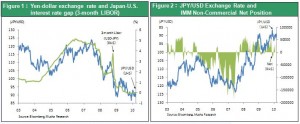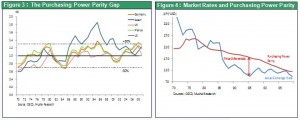The impending end of the U.S. recovery and speculation-fueled weakness of the dollar
The U.S. economic rebound has reached the point where no one can deny that this is a true recovery. And now we are seeing the shift in the market’s direction resulting from this realization. In stock markets, both the S&P 500 and FTSE 100 have climbed to new highs following the plunge sparked by the financial crisis. Stock markets in the world’s major countries have completed the corrections that took place in January and February and are now starting to stage renewed rallies. In 2010, U.S. and U.K. stock markets have been leading the way up as stock prices in Continental Europe, Japan and emerging countries follow. This leadership shows that the market-based economy of the United States was able to respond to the financial crisis with the greatest speed and flexibility in the world. This is why the U.S. is currently emerging as the leader of the global economic recovery. During the downturn, the media focused on rising U.S. unemployment. But reporters completely overlooked an even more important story: the unprecedented streamlining of U.S. companies. This is the real driving force behind the U.S. economic recovery.
The dollar carry trade is coming to an end
I believe the U.S. economic recovery will reverse the direction of the dollar-yen exchange rate. U.S. policymakers are discussing options for an exit strategy for monetary easing. We have already seen an increase in the discount rate. First is an end to purchases of Treasuries by the Fed and next will probably be the end to mortgage-backed security purchases as well in order to move away from extreme easy-money policies. Once U.S. interest rates rise, investors will no longer be able to use cheap dollar-denominated loans to fund global investments and the dollar carry trade. At the same time, the Bank of Japan appears to be about to strengthen its policy of quantitative easing. As a result, the yen’s three-month LIBOR has fallen below the three-month dollar LIBOR for the first time in six months. If the dollar carry trade winds down, the yen is very likely to emerge as the new currency of choice for procuring funds. Moreover, once this happens, the massive amount of personal savings in Japan that is earning no interest will probably start flowing overseas. People will be seeking higher interest rates along with foreign exchange gains based on expectations for a weaker yen. I expect that this enormous flow of yen savings to other countries will fuel a correction in the yen’s value that will eliminate the current overvaluation of about 30% relative to the yen’s purchasing power parity (\115 to the dollar in 2009).

Japan will not be penalized again by a strong yen
Would everyone agree to the switch to a cheaper yen? If so, that would mean a complete absence of any major buyers of the yen. Global speculators (investors) will be seeking a currency to replace the dollar as a funding source. Everyone will be drawn to the yen, which is the world’s only currency with a zero interest rate and an overvalued exchange rate. Driving down the yen’s value is also an urgent issue for the Japanese government and Bank of Japan in order to fight deflation. A cheaper yen is also attractive for Japan’s savers, who have been enduring a period of absolutely no returns. For these people, the yen’s depreciation would create a rare opportunity to earn a high return from both interest rate differentials and exchange rate gains. Of course, Japan’s exporters and overseas importers of Japanese goods will all welcome a cheaper yen with open arms. Only overseas companies that compete with Japanese exports may oppose a decline in the yen’s value. But the need to oppose a weaker yen is much less than in the past. This is because the factors that led to the extended strength of the yen starting in the 1980s to penalize Japan (an appreciation to a level far above purchasing power parity) no longer exist. Consequently, there is no reason for anyone to oppose a cheaper yen.
The risk of Japan moving away from the United States
Investors should turn their attention instead to the emerging risk associated with the possibility of Japan adopting a political stance that is no longer aligned with the United States. Japan is drifting because the country has lost its faith in market economics and globalization. This poses a significant risk regarding global stability and to avoid this, it means global forces need to prop up Japan’s economy by accepting a weaker currency. If the Hatoyama-led Democratic Party of Japan administration properly and quickly resolves the numerous problems that Japan faces, we will probably see a big downturn in the yen’s value.
For Japan, moving away from the United States will set in motion a virtuous cycle with a recovery in exports, a change in the direction toward a cheaper yen, the end of deflation, and an increase in prices of stocks and other assets. It is only a matter of time until the pessimists find themselves with nothing to stand on.




